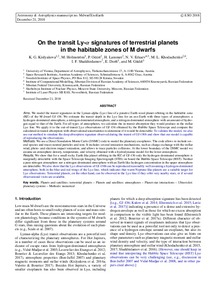Показать сокращенную информацию
Transit Lyman-α signatures of terrestrial planets in the habitable zones of M dwarfs
| Автор | Kislyakova, K. G. | |
| Автор | Holmström, M. | |
| Автор | Odert, P. | |
| Автор | Lammer, H. | |
| Автор | Erkaev, N. V. | |
| Автор | Khodachenko, M. L. | |
| Автор | Shaikhislamov, I. F. | |
| Автор | Dorfi, E. | |
| Автор | Güdel, M. | |
| Дата внесения | 2020-01-20T08:04:32Z | |
| Дата, когда ресурс стал доступен | 2020-01-20T08:04:32Z | |
| Дата публикации | 2019-03 | |
| Библиографическое описание | Kislyakova, K. G. Transit Lyman-α signatures of terrestrial planets in the habitable zones of M dwarfs [Текст] / K. G. Kislyakova, M. Holmström, P. Odert, H. Lammer, N. V. Erkaev, M. L. Khodachenko, I. F. Shaikhislamov, E. Dorfi, M. Güdel // ASTRONOMY & ASTROPHYSICS. — 2019. — Т. 623. | |
| ISSN | 14320746 | |
| URI (для ссылок/цитирований) | https://www.aanda.org/articles/aa/abs/2019/03/aa33941-18/aa33941-18.html | |
| URI (для ссылок/цитирований) | https://elib.sfu-kras.ru/handle/2311/129824 | |
| Аннотация | Aims: We modeled the transit signatures in the Lyman-alpha (Ly-α) line of a putative Earth-sized planet orbiting in the habitable zone (HZ) of the M dwarf GJ 436. We estimated the transit depth in the Ly-α line for an exo-Earth with three types of atmospheres: a hydrogen-dominated atmosphere, a nitrogen-dominated atmosphere, and a nitrogen-dominated atmosphere with an amount of hydrogen equal to that of the Earth. For all types of atmospheres, we calculated in-transit absorption they would produce in the stellar Ly-α line. We applied it to the out-of-transit Ly-α observations of GJ 436 obtained by the Hubble Space Telescope (HST) and compared the calculated in-transit absorption with observational uncertainties to determine if it would be detectable. To validate the model, we also used our method to simulate the deep absorption signature observed during the transit of GJ 436b and showed that our model is capable of reproducing the observations. Methods: We used a direct simulation Monte Carlo (DSMC) code to model the planetary exospheres. The code includes several species and traces neutral particles and ions. It includes several ionization mechanisms, such as charge exchange with the stellar wind, photo- and electron impact ionization, and allows to trace particles collisions. At the lower boundary of the DSMC model we assumed an atmosphere density, temperature, and velocity obtained with a hydrodynamic model for the lower atmosphere. Results: We showed that for a small rocky Earth-like planet orbiting in the HZ of GJ 436 only the hydrogen-dominated atmosphere is marginally detectable with the Space Telescope Imaging Spectrograph (STIS) on board the HST. Neither a pure nitrogen atmosphere nor a nitrogen-dominated atmosphere with an Earth-like hydrogen concentration in the upper atmosphere are detectable. We also showed that the Ly-α observations of GJ 436b can be reproduced reasonably well assuming a hydrogen-dominated atmosphere, both in the blue and red wings of the Ly-α line, which indicates that warm Neptune-like planets are a suitable target for Ly-α observations. Terrestrial planets, on the other hand, can be observed in the Ly-α line if they orbit very nearby stars, or if several observational visits are available. | |
| Тема | planets and satellites | |
| Тема | terrestrial planets | |
| Тема | atmospheres | |
| Тема | planet-star interactions | |
| Тема | ultraviolet | |
| Тема | planetary systems | |
| Название | Transit Lyman-α signatures of terrestrial planets in the habitable zones of M dwarfs | |
| Тип | Journal Article | |
| Тип | Journal Article Preprint | |
| ГРНТИ | 41.23.21 | |
| Дата обновления | 2020-01-20T08:04:32Z | |
| DOI | 10.1051/0004-6361/201833941 | |
| Институт | Политехнический институт | |
| Подразделение | Кафедра прикладной механики | |
| Журнал | ASTRONOMY & ASTROPHYSICS | |
| Квартиль журнала в Scopus | Q1 | |
| Квартиль журнала в Web of Science | Q1 |

